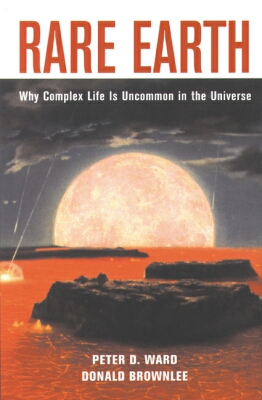

| RARE EARTH Why Complex Life Is Uncommon in the Universe Peter D. Ward Donald Brownlee New York: Copernicus, 2000 |
Rating: 4.0 High |
|||
| ISBN 0-387-98701-0 | 333p. | HC/GSI | $27.50 | |
Science is only now discovering how many factors must come out just right in order to create a world that is hospitable to the development of large animals and ultimately intelligent life forms such as ourselves.
| The world must: | If not: |
|---|---|
| Not be in an elliptical galaxy | Stars there are too old to contain the amounts of heavy elements required to form rocky planets the size of Earth. Also, most solar-mass stars have become red giants, roasting any inner planets they might have. |
| Not be in a globular star cluster | Stars there are too old to contain the amounts of heavy elements required to form rocky planets the size of Earth. Also, most solar-mass stars have become red giants, roasting any inner planets they might have, and the stars are so close that planetary orbits are unlikely to be stable for long enough. |
| Be located within a spiral galaxy's habitable zone | Too close to galaxy center, planet sterilized by supernovae, gamma-ray bursters, or central black hole; too far out, insufficient heavy elements. |
| Be in a single-sun solar system. | Multiple stars in a system perturb the orbits of any planets, negating long-term stability. |
| Orbit a suitably long-lived, stable star. | Large stars burn too quickly to give complex life time to evolve; stars with highly variable output change the surface temperatures of their rocky planets too much. |
| Orbit a star of a mass not much less than that of our sun. | Planets of small stars would have to orbit close to be warm enough for life; then they would be tidally locked to the star, and life probably could not develop under that condition. |
| Be located within solar system habitable zone. | Planet's surface is too hot or too cold for life. |
| Have a giant planet in the system to act as an "asteroid sink". | No gas giant means a longer period of bombardment by "space rubble". |
| Not have the giant planet too close, or in a highly elliptical orbit. | Gas giants near sun ("hot Jupiters") tend to toss rocky planets out of the system. Those with elliptical orbits are similarly disruptive.1 |
| Have radioisotopes to keep core molten, drive magnetic field, make volcanoes & plate tectonics, enhance biodiversity. | No protection from star's particle radiation, no continents, no continental drift, no carbonate-silicate cycle to prevent runaway greenhouse effect |
| Have a relatively large moon to stabilize its obliquity.2 | Planet wobbles, leading to excessive surface temperature variations over time. |
| Incorporate sufficient heavy chemical elements (carbon, silicon, oxygen, nitrogen, phosphorus, and various metals) along with hydrogen in the form of water. | Without an abundance of such elements (found in generation 2 and later stars), rocky planets would be too small, and the essentials of life too scarce. |
| Not have so much water that large continents cannot form. | The carbonate-silicate cycle will not operate, or will be much less efficient.3 The likely result is a runaway greenhouse effect. |
| Have enough mass to induce sufficient gravity to hold atmosphere and water. | These vital substances escape too soon. |
| Undergo period(s) of global freezing, with recovery to warm temperatures. | Hypothetically, animal life will not develop without such "snowball" events. |

 To contact Chris Winter, send email to this address.
To contact Chris Winter, send email to this address.